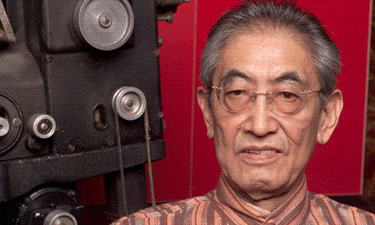In Memoriam
Nagisa Oshima
Japanese film-maker best known for the sexually explicit In the Realm of the Senses and Merry Christmas, Mr Lawrence, starring David Bowie
 Nagisa Oshima at the time of Gohatto, his highly stylised and oblique samurai film Nagisa Oshima at the time of Gohatto, his highly stylised and oblique samurai film. Photograph: Corbis In a sense, it is unfortunate that the Japanese director Nagisa Oshima, who has died aged 80, was more infamous than famous, due to one film, In the Realm of the Senses (also known as Ai No Corrida, 1976). Although it was, for many, in the realms of pornography, the film was a serious treatment of the link between the political and the sexual, eroticism and death (previously dealt with in Bernardo Bertolucci's Last Tango in Paris), and a breakthrough in the representation of explicit sex in mainstream art cinema. Like Bertolucci, Oshima was held and acquitted on an obscenity charge. Based on a true cause célèbre, In the Realm of the Senses tells of a married man and a geisha, who retreat from the militarist Japan of 1936 into a world of their own, where they obsessively act out their sexual fantasies. Finally, in the quest for the ultimate orgasm, she strangles and then castrates him. Oshima uses the formula of kabuki theatre and taps the rich erotic literary history of feudal Japan. Although In the Realm of the Senses was his biggest commercial success, it was not his best film, and his reputation declined over the following decades, during which he made only a few films. Nagisa Oshima's In the Realm of the Senses Nagisa Oshima's In the Realm of the Senses was a serious treatment of the link between the political and the sexual, eroticism and death. Photograph: Ronald Grant Archive Born in Kyoto, Oshima studied political history at Kyoto University, where he was a student leader involved in leftwing activities, prior to graduating in 1954. He then became a film critic and later editor-in-chief of the film magazine Eiga Hihyo, before learning his craft as an assistant director at the Shochiku Studios. Oshima started directing his first features at the time of the French New Wave and was particularly influenced by Jean-Luc Godard. His first three films were fairly undistinguished seishun eiga (youth films), which included a few experimental sequences. For example, in Naked Youth (1960) there is a long single-shot sequence in which the young hero slowly munches an apple. The neorealist Night and Fog in Japan (1960) – the title deliberately designed to echo Alain Resnais's documentary on Auschwitz – was a despairing indictment of the disunity of the Japanese left, and what Oshima saw as the betrayal of revolutionary action by the Japanese Communist party. The film, which contains only 43 shots, was withdrawn by the studio three days after its release, which pushed him to working as an independent and to found his own production company, Sozosha, with the actor Akiko Koyama, whom he married in 1960. The Catch (1961), Oshima's first independent movie, set the tone for much that was to follow in its concern about racism and brutality, whether institutionalised or personal. Filmed in long takes with minimum camera movement, it tells the savage story of an African-American PoW held hostage by a small village. While waiting for the military police to remove their "catch", the villagers make the man a scapegoat for all their own problems, eventually murdering him. Oshima's next important film was Violence at Noon (1966), a deliberately obscure study of a sex criminal. It is very rarely seen because of a legal dispute over the film's distribution abroad. In contrast to The Catch, it was made in CinemaScope and was frenetically cut (it contains 2,000 shots). The unusual Tales of the Ninja (1967) also featured rapid cutting and was made up entirely of panels from a violent and erotic manga comic book. |
Death by Hanging (1968), a startling, angry and blackly humorous film, told of an intelligent young Korean, who is being hanged for the rape and murder of two Japanese girls, but his body refuses to die. It begins like a documentary on the death penalty, becoming more and more unreal as the arguments are pursued in seven Brechtian chapters. The main subject that emerges is the shameful treatment by the Japanese of the Korean minority, a fact of crucial importance to the understanding of the film.
Coming hot on the heels of the student revolt of 1968 was Diary of a Shinjuku Thief, an explosive agit-prop movie equating sexual liberation with revolution, whose impact has cooled only marginally. Using black and white with colour inserts and mixing realistic and theatrical acting and cinéma vérité techniques, it involves a young student who is caught shoplifting in a bookshop by a girl masquerading as an assistant, with whom he goes on to have a sexually unfulfilled affair. After seeking sexual advice, they finally find ecstasy as a street riot breaks out. Three Resurrected Drunkards (1968) literally restarts halfway through. This could cause some unknowing audience members to start to protest, thinking that the projectionist was accidentally replaying the opening reel. That dated oddity was followed by Boy (1969), one of Oshima's most accessible and "finished" films. Like most of his films, it was taken from a true story – in this case, that of a 10-year-old boy who is trained by his parents to be knocked down by cars so that they can demand money from the frightened drivers before moving on to the next town. It was told with remarkable social and psychological insight, and the performances, the colour and the CinemaScope screen are all handled in a masterly manner. The Ceremony (1971) was Oshima's most ambitious film to that date: no less than the history of Japan from the end of the second world war to the present day, represented by a large and influential family. Each stage is marked by a specific ceremony such as an anniversary, a wedding or a funeral, exposing Oshima's deeply ambivalent attitude to Japanese society. "Ceremonies are a time when the special characteristics of the Japanese spirit are revealed. It is this spirit that concerns and worries me," Oshima explained. Empire of Passion (1978), a less sexually explicit companion piece to In the Realm of the Senses, is a ghost story with an amour fou at its centre. In a village in 1895, an old rickshaw man is murdered by his wife and her young lover. Three years later, the old man's ghost appears, reawakening their guilt and leading to the exposure of their crime. Although the film won Oshima the best director award at Cannes, he seemed to have one keen eye on the audience's emotions and another on the box-office. The social conviction and complexity of his earlier films seemed to have evaporated. Oshima's only English-language film was Merry Christmas, Mr Lawrence (1983), based on a novel by Laurens van der Post set in a Japanese PoW camp. It attempted to explain that despite the wartime atrocities there were many soldiers with noble and gentle qualities. The main interest lay in the homoerotic relationship between a prisoner (David Bowie) and the commander of the camp (Ryuichi Sakamoto), though the two actors – both pop stars – give stilted performances. The shade of Luis Buñuel hangs over the French-made Max, Mon Amour (1986), about a British diplomat in Paris, who discovers that his bored wife (Charlotte Rampling) has rented an apartment where she can visit her lover Max, a chimpanzee. This reasonably witty black comedy had little success, and Oshima gave up directing to become a popular talkshow host on Japanese television. He tried for some years to set up Hollywood Zen, his script about Sessue Hayakawa, the Japanese actor who became a Hollywood star in the silent era. In 1999, he made a welcome return to form with Gohatto (Taboo), a highly stylised and oblique samurai film about homosexual passions aroused in the very restricted society for a beautiful young fencer. It was to be his last film, following which he suffered a series of strokes. He is survived by Koyama, who appeared in several of his films. • Nagisa Oshima, film director, born 31 March 1932; died 15 January 2013
Ronald Bergan |



